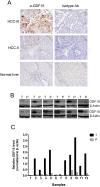Association of serum level of growth differentiation factor 15 with liver cirrhosis and hepatocellular carcinoma
- PMID: 25996938
- PMCID: PMC4440744
- DOI: 10.1371/journal.pone.0127518
Association of serum level of growth differentiation factor 15 with liver cirrhosis and hepatocellular carcinoma
Abstract
Hepatocellular carcinoma (HCC) and liver cirrhosis are associated with high mortality worldwide. Currently, alpha-fetoprotein (AFP) is used as a standard serum marker for the detection of HCC, but its sensitivity and specificity are unsatisfactory, and optimal diagnostic markers for cirrhosis are lacking. We previously reported that growth differentiation factor 15 (GDF15) was significantly induced in HCV-infected hepatocytes. This study aimed to investigate GDF15 expression and its correlation with hepatitis virus-related liver diseases. A total of 412 patients with various liver diseases were studied. Healthy and Mycobacterium tuberculosis-infected subjects were included as controls. Serum and tissue GDF15 levels were measured. Serum GDF15 levels were significantly increased in patients with HCC (6.66±0.67 ng/mL, p<0.0001) and cirrhosis (6.51±1.47 ng/mL, p<0.0001) compared with healthy controls (0.31±0.01 ng/mL), though the GDF15 levels in HBV and HCV carriers were moderately elevated (1.34±0.19 ng/mL and 2.13±0.53 ng/mL, respectively). Compared with HBV or HCV carriers, GDF15 had a sensitivity of 63.1% and a specificity of 86.6% at the optimal cut-off point of 2.463 ng/mL in patients with liver cirrhosis or HCC. In HCC patients, the area under the receiver operating curve was 0.84 for GDF15 and 0.76 for AFP, but 0.91 for the combined GDF15 and AFP. Serum GDF15 levels did not significantly differ between the high-AFP and low-AFP groups. GDF15 protein expression in HCC was significantly higher than that in the corresponding adjacent paracarcinomatous tissue and normal liver. Using a combination of GDF15 and AFP will improve the sensitivity and specificity of HCC diagnosis. Further research and the clinical implementation of serum GDF15 measurement as a biomarker for HCC and cirrhosis are recommended.
Conflict of interest statement
Figures





References
-
- D'Ippolito G, Torres LR, Saito Filho CF, Ferreira RM. CT and MRI in monitoring response: state-of-the-art and future developments. Q J Nucl Med Mol Imaging. 2011;55(6):603–19. . - PubMed
-
- Di Bisceglie AM, Sterling RK, Chung RT, Everhart JE, Dienstag JL, Bonkovsky HL, et al. Serum alpha-fetoprotein levels in patients with advanced hepatitis C: results from the HALT-C Trial. J Hepatol. 2005;43(3):434–41. . - PubMed
-
- Ezaki T, Yukaya H, Ogawa Y, Chang YC, Nagasue N. Elevation of alpha-fetoprotein level without evidence of recurrence after hepatectomy for hepatocellular carcinoma. Cancer. 1988;61(9):1880–3. . - PubMed
Publication types
MeSH terms
Substances
LinkOut - more resources
Full Text Sources
Other Literature Sources
Medical

